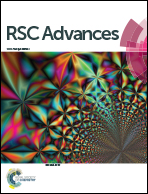Breaking bonds with electrons: stepwise and concerted reductive cleavage of C–S, C–Se and Se–CN bonds in phenacylthiocyanates and phenacylselenocyanates†
Abstract
The mechanistic aspects of the electrochemical reduction of phenacylthio- and selenocyanates have been studied. With phenacylthiocyanates (1), a change in the reductive cleavage mechanism is observed as a function of the substituent on the phenyl ring. While a stepwise mechanism involving the intermediacy of a radical anion is followed for substrates bearing a strong electron withdrawing group, such as cyano and nitro substituent (1d, 1e), and a concerted mechanism is favoured for compounds bearing an electron-donating or no substituent on the phenyl ring (1a–c). A regioselective bond cleavage leads to the fragmentation of the CH2–S bond with all compounds 1a–e, further yielding the corresponding 1,4-diketone (3) as products. Contrastingly, with phenacylselenocyanates (2), two different reductive cleavages occur involving the breaking of both the CH2–Se and Se–CN bonds. Several products are obtained, all coming from nucleophilic attack at the α (phenacyl) carbon or the selenium atom.


 Please wait while we load your content...
Please wait while we load your content...